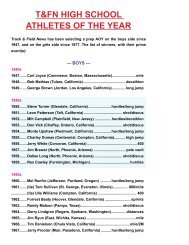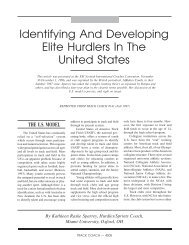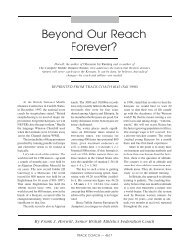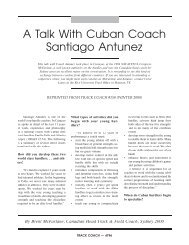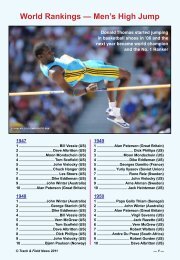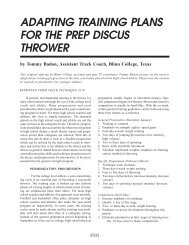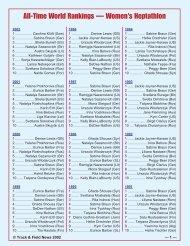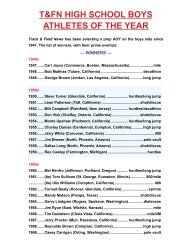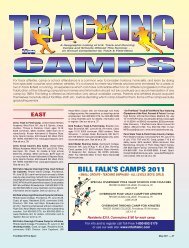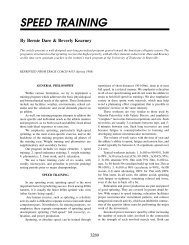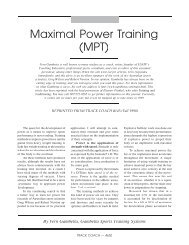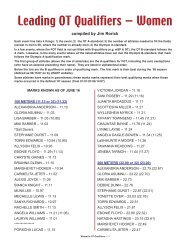Teaching The Women's Hammer - Track & Field News
Teaching The Women's Hammer - Track & Field News
Teaching The Women's Hammer - Track & Field News
You also want an ePaper? Increase the reach of your titles
YUMPU automatically turns print PDFs into web optimized ePapers that Google loves.
Are <strong>The</strong>re Any Differences?<br />
<strong>Teaching</strong> <strong>The</strong> Women’s<br />
<strong>Hammer</strong><br />
We welcome Larry Judge back to these pages. During the 1999 indoor season, his pupils<br />
were outstanding: Dawn Ellerbe threw 22.94 in the weight, 1an American record, and Kevin<br />
Mannon bagged a 22.76 collegiate record. Not only can Judge coach, but he writes with<br />
clarity about the event. This article is timely, as it summarizes some very important points<br />
on the coaching of in the hammer. His presentation on the hammer at the November, 1998,<br />
Level III school to a group which included hammer notables Harold Connolly and Boris<br />
Zaitchuk was very well received.<br />
REPRINTED FROM TRACK COACH #148 (SUMMER 1999)<br />
GENDER EQUITY<br />
Gender equity is a term that<br />
evolved from Title IX and has athletic<br />
directors scrambling to improve<br />
opportunities for women across the<br />
board. Gender equity has definitely<br />
affected the sport of track and field.<br />
Historically, events such as the hammer,<br />
pole vault, and steeplechase have<br />
been thought to be for men only.<br />
At the 1999 World Championships,<br />
the hammer will be contested<br />
by both men and women. This is<br />
due to the gradual emergence of the<br />
women’s hammer over the last ten<br />
years. In 1996, the NCAA Division<br />
I Championships added the hammer<br />
throw for women. This was a giant<br />
step in the emergence of the event, not<br />
only for women but also for men.<br />
Bringing the hammer throw into<br />
the national championships has allowed<br />
more opportunities for women<br />
to compete. Subsequently, most major<br />
conference championships have now<br />
included the event. This has led more<br />
universities to build throwing facilities<br />
and invest money into the hammer.<br />
<strong>Field</strong> event coaches have been forced<br />
to learn more about the event.<br />
<strong>The</strong> university system is the key<br />
to track and field development in this<br />
country. Ultimately, more schools will<br />
have to hire or train competent coaches<br />
and build adequate and safe training<br />
facilities. Because of the growth of<br />
the women’s hammer, coaches must<br />
teach the event not only to men but to<br />
women. Some of the universities that<br />
added the event for women may now<br />
offer the same opportunity that in the<br />
past was not available for men. This<br />
is a win-win situation for everyone<br />
involved.<br />
By Larry Judge, Ph. D.<br />
Head <strong>Track</strong> Coach, University of Wyoming<br />
TRACK COACH — 4713
TEACHING THE<br />
HAMMER TO WOMEN:<br />
IS THERE REALLY ANY<br />
DIFFERENCE?<br />
<strong>The</strong> teaching progression for the<br />
event is the same for men and women.<br />
According to a recent study by Romanov<br />
and Vrublevsky (1998), women<br />
throwers follow a rhythmic throwing<br />
structure that follows in many aspects<br />
the technique followed by men.<br />
<strong>Teaching</strong> the winds, practicing the<br />
turning pattern, and drilling the release<br />
are all things a beginning thrower must<br />
do, regardless of gender. Because the<br />
women use the same implement (4k)<br />
at all levels, it is possible to use the<br />
competition weight for teaching purposes.<br />
When teaching a collegiate male<br />
it is advisable to start with a 12-or<br />
14-pound ball.<br />
When teaching women, the emphasis<br />
should be on drills and repetition<br />
as this will help establish the proper<br />
technical pattern. <strong>The</strong>y are typically<br />
not as concerned about distance immediately.<br />
Because of the weight of the<br />
implement, most women throwers will<br />
be able to rely on speed and technique<br />
to make the implement go. <strong>The</strong> first<br />
month of training should be spent on<br />
drills. Proper execution of drills will<br />
ensure later success.<br />
<strong>The</strong> differences in the amount<br />
of muscle mass, the distribution of<br />
muscle, and the testosterone level of<br />
women when compared to men of similar<br />
age, total body mass, and training<br />
state, may result in different workouts<br />
for male and female athletes.<br />
Women’s mean total body strength<br />
is 63.5% of men’s total body strength,<br />
according to Laubach (1976). According<br />
to Wright (1980), men have ten<br />
times the testosterone levels of women.<br />
Researchers have examined the role of<br />
body size in the strength differences<br />
between men and women.<br />
According to Wilmore, (1974),<br />
when body size is accounted for,<br />
women are weaker in upper body<br />
strength than are men. Men proved to<br />
be 63% stronger in the bench press than<br />
women. A recent study by Hoffman,<br />
et al., using isokinetic testing found<br />
men to be 50% stronger in absolute<br />
terms when adjusted for height and<br />
lean body mass. Though women may<br />
be weaker than men, keep in mind the<br />
4k hammer may not be as physically<br />
demanding as the 16lb is for their male<br />
counterparts.<br />
As a result of their flexibility in<br />
the upper body and natural tendency to<br />
be proportionally stronger in the lower<br />
body, women may be better suited<br />
for the event than men. <strong>The</strong> hammer<br />
thrower must possess core strength as<br />
well as lower body strength and power.<br />
Most hammer throwers avoid a lot of<br />
upper body work like the bench press<br />
because it tightens up the chest and<br />
shoulders.<br />
In my experience, women often<br />
pick up the basic technique of the event<br />
quicker than men probably because<br />
they tend to be a little more technically<br />
oriented. With their upper body<br />
flexibility, they tend not to muscle<br />
the implement; they let the movement<br />
happen.<br />
Men have a tendency to drag the<br />
ball because it feels heavy and they<br />
try to overpower the hammer with<br />
the upper body. Women often have an<br />
easier time learning the event because<br />
of their stature and the fact that the<br />
implement weighs only 4 kilos and<br />
the weight does not change from high<br />
school to college.<br />
Improving strength in the lower<br />
body is usually not a problem for<br />
women. However, most females must<br />
also work hard to improve their pull<br />
strength doing cleans, snatches, jerks,<br />
and high pulls. <strong>The</strong>y must also pay<br />
special attention to improving their<br />
core strength or torso power. This is<br />
very specific to hammer throwing and<br />
most female hammer throwers can benefit<br />
from torso exercises in the weight<br />
room in addition to the medicine ball<br />
and kettle bell throws.<br />
<strong>The</strong> biggest difference between<br />
training men and women may be found<br />
when designing the workout during<br />
the competitive season. Because of<br />
differences in hormone levels women<br />
cannot back off as early as men when<br />
peaking.<br />
DESCRIPTION OF<br />
TECHNIQUE<br />
This description of the hammer<br />
throw is based on a three-turn throw.<br />
This style of throwing was chosen<br />
because it is a common style used by<br />
the typical intermediate level collegiate<br />
thrower.<br />
It must be kept in mind, however,<br />
that a four-turn technique has been<br />
successfully employed by advanced<br />
throwers and ultimately may be advantageous<br />
for women because of<br />
their smaller feet. It must also be<br />
remembered that many throwers use<br />
different types of starts.<br />
<strong>The</strong> throw has seven parts:<br />
1. <strong>The</strong> Grip and Starting Position<br />
2. <strong>The</strong> Winds<br />
3. <strong>The</strong> First Turn<br />
4. <strong>The</strong> Second Turn<br />
5. <strong>The</strong> Third Turn<br />
6. <strong>The</strong> Release<br />
STARTING POSITION<br />
THE GRIP<br />
A right-handed thrower should<br />
grip the handle in the left hand at the<br />
mid-part of the fingers (glove hand).<br />
<strong>The</strong>n place the right hand over the<br />
left and cross the thumbs with the left<br />
thumb on top; or if more comfortable,<br />
the thumbs can be side by side rather<br />
than overlap. <strong>The</strong>re is no exact focal<br />
point, but the thrower should look into<br />
the horizon and slightly to the right and<br />
back (toward the rear of the circle).<br />
THE START<br />
<strong>The</strong> start includes the winds and<br />
the preliminary movements preceding<br />
the winds. <strong>The</strong> key to consistent throwing,<br />
the start sets up the posture and<br />
TRACK COACH — 4714
the timing of the throw. It is one of the<br />
areas that can vary among throwers.<br />
<strong>The</strong> start should best suit the individual<br />
thrower to put her in the best position<br />
to enter the transition phase and ultimately<br />
accelerate the hammer. <strong>The</strong>re<br />
are three major start types.<br />
1. <strong>The</strong> Static Start<br />
Before performing the wind, the<br />
thrower must first decide where to<br />
place the hammer in the ring. For a<br />
beginner it is recommended to place the<br />
implement about three feet behind the<br />
right foot for a right-handed thrower.<br />
This is commonly referred to as the<br />
static start. This is a no-nonsense way<br />
to start the throw because there are<br />
very few preliminary movements and<br />
it is very easy to teach.<br />
• <strong>The</strong> athlete stands at the rear of the<br />
circle, her back facing the direction<br />
of the throw.<br />
• <strong>The</strong> athlete’s base should be<br />
shoulder width in order to have a<br />
comfortable and balanced starting<br />
position.<br />
• <strong>The</strong> athlete’s head should be up,<br />
shoulders should be level, and eyes<br />
focused outside the ring slightly to<br />
the right.<br />
(<strong>The</strong> reason for looking to the right<br />
is to catch the hammer early in front<br />
of the thrower to create a more balanced<br />
system to alleviate the problem<br />
of dragging the ball.)<br />
Important Points<br />
• Look at or behind the ball when it<br />
is in front of you.<br />
• Lock down the hammer on the first<br />
wind eighty degrees to your torso.<br />
• Move as the system (hammer,<br />
knees, hips, hand, head) moves,<br />
simultaneously aligned with one<br />
another.<br />
• Keep an erect torso with a slight<br />
bend in the legs.<br />
• Extend relaxed arms to extend the<br />
radius.<br />
2. <strong>The</strong> Pendulum Start<br />
In the hammer, the intermediateto-advanced<br />
thrower could perform a<br />
preliminary movement with the hammer<br />
to create momentum for the winds.<br />
This pendulum movement can vary<br />
according to the athlete’s preference.<br />
A suggested preliminary movement is<br />
to set the hammer next to the left leg<br />
and swing the hammer from the left<br />
hip to the front as the athlete begins<br />
to wind. Another option is to start the<br />
hammer in front of the athlete between<br />
the legs. Basically, the pendulum gets<br />
the ball moving prior to the wind.<br />
3. <strong>The</strong> Dynamic or Step-in Start<br />
In this start, the athlete starts with<br />
the left foot staggered approximately<br />
one foot behind the right. <strong>The</strong> leg<br />
remains staggered during the first<br />
wind and the athlete will step in to the<br />
parallel position following the second<br />
wind. This type of start is often chosen<br />
because it helps the thrower establish<br />
rhythm in the start.<br />
PERFORMING THE<br />
WINDS<br />
<strong>The</strong>re are usually two winds, or<br />
complete revolutions of the hammer<br />
head, before the turns begin. <strong>The</strong><br />
winds must be performed with the<br />
same rhythm as employed in all the<br />
turns of the throw. Since the position<br />
of the low point is so crucial, the winds<br />
play a key role in the success of the<br />
throw. <strong>The</strong> winds could be thought of<br />
as standing turns.<br />
One of the important concepts to<br />
keep in mind during the winds is opposition.<br />
As the hammer is gradually<br />
accelerated through these two revolutions,<br />
the thrower’s center of mass is<br />
shifted in the opposite direction from<br />
the hammer in order to maintain balance<br />
between thrower and hammer.<br />
<strong>The</strong> opposition of the thrower’s<br />
body weight and the hammer is what<br />
generates force in the winds. On the<br />
winds the low point is at the center or<br />
slightly to the right of center on the<br />
first wind. During the second wind,<br />
the body movements are more exaggerated<br />
than during the first because of<br />
the increase in the hammer’s velocity<br />
and, thus there is an increase in the<br />
centripetal and centrifugal forces. <strong>The</strong><br />
right foot must be straight, never being<br />
allowed to open so that the hip axis<br />
remains square across the front while<br />
the shoulder axis turns right to pick<br />
up the hammer at its apex.<br />
Throughout the winds the angle of<br />
the hammer’s upward path increases<br />
slightly, with the low point of the swing<br />
slightly left of center as she faces the<br />
back of the circle. <strong>The</strong> second wind<br />
should be faster than the first as it sets<br />
the rhythm for the turn.<br />
Because of the mass of the implement<br />
many athletes have trouble starting<br />
the throw. <strong>The</strong> wind often causes<br />
many problems if the athlete is off<br />
balance. <strong>The</strong> left shoulder is the axis<br />
of the winds. Although body weight is<br />
moving opposite the hammer, keeping<br />
the winds moving around the left shoulder<br />
is important because the shoulder<br />
needs to be kept low on the entrance.<br />
An off-balance start will take energy<br />
away from the turns and will lead to<br />
a weak finish. A poor start can lead<br />
to problems in the first turn.<br />
TEACHING THE WINDS<br />
Preliminary swings are performed<br />
to get the implement moving as the<br />
athlete enters the first turn. In teaching<br />
the winds it is best to use a 3k<br />
medicine ball on a rope. A way to cue<br />
the teaching of the winds is “Sweep,<br />
Curl, Form the Window, Comb the<br />
Hair, and Twist.” <strong>The</strong> thrower sweeps<br />
the ball to the front of the body, curls<br />
her left arm when the ball passes her<br />
body, lets the handle pass over the<br />
midline of the head, and then twists<br />
the shoulders to catch the ball behind<br />
her. <strong>The</strong> shoulders rotate to bring the<br />
ball forward and then turn back to<br />
meet the hammer as it moves to the<br />
thrower’s right.<br />
At that point, the hands should<br />
be kept above the shoulders. When<br />
the athlete curls the left arm after the<br />
sweep she actually forms a window in<br />
TRACK COACH — 4715
front of her prior to the twist of the<br />
shoulders.<br />
<strong>The</strong> thrower should not let the<br />
hands pass beyond the midline of the<br />
body and should not try to reach back<br />
over the head past the middle of the<br />
head.<br />
<strong>The</strong> winds must be symmetrical<br />
with almost equal forces occurring to<br />
the left and the right. For this to happen<br />
the thrower must think of “pushing”<br />
with the right arm and not pulling<br />
with the left as the implement moves<br />
to the thrower’s right. <strong>The</strong> athlete<br />
should be able to perform the winds<br />
empty-handed, emphasizing the sweep,<br />
curl, form the window, comb the hair,<br />
and twist, and lifting the heels at the<br />
proper time.<br />
Have the athlete perform multiple<br />
winds with a medicine ball on a rope in<br />
order to feel the smooth sweeping motion.<br />
After the athlete has mastered the<br />
medicine ball on a rope, try the hammer.<br />
Sets of 5 to 10 consecutive winds<br />
really helps in teaching rhythm.<br />
• <strong>The</strong> feet are parallel and slightly<br />
wider than shoulder width apart,<br />
and the toes are one inch in from<br />
the edge of the circle.<br />
• <strong>The</strong> knees are bent at an angle of<br />
approximately 150 degrees.<br />
• <strong>The</strong> feet are parallel to help create<br />
a blocking action on the wind.<br />
• Block the right leg at the back of<br />
the circle in a good solid squat<br />
position with the torso erect.<br />
• Keep your eyes on your focal point,<br />
which is slightly to the right to<br />
catch the ball in front of you. It is<br />
crucial to keep the head in a fixed<br />
position because a common fault is<br />
to lead with the head and brake the<br />
system on the first turn by leading<br />
left with the head or left knee.<br />
• <strong>The</strong> athlete straightens his back<br />
and draws the left arm forward<br />
and upward with a smooth lifting<br />
movement. Cue: Sweep.<br />
• At the same time, the upper body<br />
is twisted to the left, beginning the<br />
wind.<br />
• <strong>The</strong> arms sweep the hammer in a<br />
wide flat path. A flat path is important<br />
for control in the first turn.<br />
When the ball is left-front, the thrower<br />
should:<br />
• Bend the elbows. Cue: Curl and<br />
Form the Window.<br />
• Lower the left shoulder.<br />
• Move the hips to the right.<br />
• Pass the hands over the midline of<br />
the head. Cue: Comb the hair.<br />
Turn the right shoulder and do<br />
not let the hands drop below the<br />
shoulders. Cue: Twist.<br />
THE TRANSITION<br />
PHASE<br />
<strong>The</strong> transition into the initial turn,<br />
wherein the body becomes a rotating<br />
axis for the hammer, begins as the<br />
hammer descends after the second<br />
wind. <strong>The</strong> transition to the first turn<br />
is one of the most difficult elements<br />
of the hammer throw. <strong>The</strong> incorrect<br />
execution of this phase reduces the<br />
effectiveness of the turns and throws<br />
off the whole throwing rhythm.<br />
During the last wind when the<br />
hammer has passed through the high<br />
point the hands stay above the shoulder<br />
and the thrower lowers her center of<br />
gravity. As soon as the hammer reaches<br />
its low point at the completion of the<br />
second wind, the right-handed thrower<br />
should let the hammer get past the<br />
left leg before starting the turn. This<br />
is commonly referred to as letting the<br />
ball run or “using the ball.”<br />
At this point, most of the weight<br />
should be on the right leg as the thrower<br />
starts to turn by pivoting on the heel<br />
of her left foot and pushing on the ball<br />
of her right foot.<br />
During the transition to the turns<br />
the body mass is kept in a central<br />
position so that the right leg does not<br />
move in an “unloaded way.” During the<br />
turns, the hammer and thrower rotate<br />
around an axis, which passes through<br />
their common center of mass.<br />
Posture and core control are very<br />
important in the transition phase. A<br />
common problem in the transition<br />
phase is breaking at the waist following<br />
the wind. As the body mass moves<br />
forward, so does the system center of<br />
gravity, moving ground contact center<br />
of pressure toward the front foot. This<br />
makes it difficult to lift the ball of the<br />
foot and begin the turn.<br />
For this position to be effective, the<br />
forward trunk lean must be countered<br />
by a backward motion of the hips.<br />
This position should be avoided by<br />
everyone except extremely advanced<br />
throwers as it often causes the athlete<br />
to stand up into the first turn.<br />
Important points following the<br />
winds: <strong>The</strong>re is a definite increase in<br />
tempo as you start the first turn, and the<br />
tempo increases with each subsequent<br />
turn. At the end of the second wind<br />
the weight should be on the left foot<br />
until the ball reaches approximately<br />
90 degrees. As the thrower moves the<br />
hammer head forcefully to the left the<br />
weight shifts to the heel of the left foot<br />
as the right leg is lifted.<br />
Key Points<br />
• At the high point of the second<br />
wind, the athlete starts to bend the<br />
knees in preparation to enter the<br />
first turn.<br />
• As the hammer comes off the second<br />
wind, the shoulders are level<br />
and the trapezius and latissimus<br />
muscles are locked down.<br />
• <strong>The</strong> lower back is straight, and the<br />
shoulders are relaxed and arms are<br />
extended.<br />
• <strong>The</strong> athlete starts turning on the<br />
left leg when the ball is past zero<br />
or left-front to the athlete.<br />
• Simultaneously (to maintain the<br />
system), the right leg starts, and<br />
the thrower turns on the left heel<br />
and the ball of the right foot.<br />
• When the hammer is at zero to 90<br />
degrees, the body weight is over<br />
the right foot, and the left leg is<br />
working against the centrifugal<br />
force of the hammer.<br />
• Enter the first turn with a moderately<br />
flat orbit keeping everything in<br />
line maintaining a 90-degree angle<br />
between the arms and torso.<br />
• <strong>The</strong> athlete turns the left foot to approximately<br />
160 degrees in the first<br />
TRACK COACH — 4716
phase of the turn, continues on the<br />
outer side of the foot, and completes<br />
the rest of the full 360-degree turn<br />
on the ball of the foot.<br />
• <strong>The</strong> thrower should then pump the<br />
right knee up over the left leg by<br />
lifting it at 80 degrees.<br />
THE TURNS<br />
<strong>The</strong> number of turns must be fixed<br />
for each thrower according to the degree<br />
of her ability and her individual<br />
level of speed and strength. This is<br />
usually two turns for the beginner and<br />
three or four turns for the intermediate<br />
or advanced thrower. A female hammer<br />
thrower can easily perform four<br />
heel turns in most cases. This makes<br />
the four-turn technique more attractive<br />
for the female thrower. Many female<br />
throwers could conceivably perform a<br />
toe turn followed by four heel turns<br />
and easily stay in the ring.<br />
<strong>The</strong> turns consist of single-support<br />
and double-support phases. During the<br />
single-support phase the athlete tries<br />
to keep the hammer system in line.<br />
<strong>The</strong> double-support phase is when the<br />
thrower actively acts upon the implement.<br />
During the first turn the trunk is<br />
erect and the left leg is locked. <strong>The</strong><br />
thrower tries to utilize inertial forces<br />
of the hammer in the single-support<br />
phase by riding the ball and being<br />
passive with the ascending hammer<br />
while also avoiding activity with the<br />
pelvis and legs.<br />
After running through the high<br />
point of the hammer, the completion<br />
of the turn on the ball of the left foot<br />
should be done actively to drive back<br />
to double support as soon as possible.<br />
Both of the feet should be parallel,<br />
with the right leg slightly behind the<br />
left at between 225 and 270 degrees<br />
at the completion of the turns. This is<br />
a key technical point as most throwers<br />
do not actively finish the turn with the<br />
left leg. This makes the acceleration<br />
phase difficult and causes the athlete<br />
to fall off the axis.<br />
<strong>The</strong> key to the “first turn” is to<br />
keep it in line with the whole “<strong>Hammer</strong><br />
System.” <strong>The</strong> feet, knees, hips,<br />
torso, arms, and head all must move<br />
together in sync. <strong>The</strong> “first turn” of<br />
the hammer throw allows the thrower<br />
to accelerate the hammer in a more<br />
gradual and fluent motion.<br />
Common faults to identify in<br />
many throwers are dragging the ball,<br />
breaking the system, and catching<br />
the hammer with the wide base when<br />
the right leg sweeps around the left.<br />
If the first turn is properly executed,<br />
the thrower should catch the ball at<br />
approximately 225 degrees. <strong>The</strong> ball<br />
should be lined up with an erect torso<br />
and head with legs bent on the ball of<br />
the right foot. <strong>The</strong> hips will be slightly<br />
in front of the hammer system. <strong>The</strong> hips<br />
will be facing 270 degrees while the<br />
shoulder axis will be at approximately<br />
225 degrees.<br />
TEACHING THE TURNS<br />
<strong>The</strong> turns are the most important<br />
component in teaching hammer technique.<br />
<strong>The</strong> turn is taught in two steps<br />
to make it as easy as possible for the<br />
athlete to understand.<br />
Step number one: Have the<br />
athlete start with the feet shoulder<br />
width apart, the knees slightly flexed<br />
and the head up. <strong>The</strong> arms will be<br />
straight and will be held together in<br />
front of the athlete. Have the athlete<br />
put her body weight on the ball of<br />
the right foot and the left heel. Have<br />
the athlete turn until she reaches 180<br />
degrees. Have the athlete repeat these<br />
180-degree rotations. When the athlete<br />
can get to this position have the athlete<br />
turn and walk in the opposite direction.<br />
This helps teach the idea of lifting the<br />
right foot to complete the turn.<br />
Step number two: Instead of<br />
having the athlete turn and walk, they<br />
must now learn how to complete the<br />
turn. Have the athlete put her body<br />
weight on the ball of the right foot<br />
and the left heel. Have the athlete<br />
turn until she reaches approximately<br />
90 degrees. At this point, the athlete<br />
picks up the right foot and continues<br />
to rotate on the side of the left foot<br />
to the ball of the foot. <strong>The</strong> right leg<br />
is kept close to the left as the athlete<br />
completes the turn on the left leg and<br />
prepares to place the right foot at 270<br />
degrees.<br />
It is important that on completion<br />
of the turn the right leg make contact<br />
through the ball of the foot. <strong>The</strong> athlete<br />
must practice performing a single turn<br />
over and over until it feels comfortable.<br />
At this point the athlete can add<br />
a second consecutive turn and then a<br />
third. It is important for an athlete to<br />
be able to perform three dry-run turns<br />
before having the athlete turn with an<br />
object.<br />
After the thrower has mastered the<br />
elementary turning action, it is time to<br />
turn with a medicine ball on a rope<br />
and then eventually with a hammer.<br />
THE WORK PHASE<br />
When the right foot is grounded<br />
at the completion of each turn, the<br />
thrower is in position to greatly accelerate<br />
the hammer. <strong>The</strong> work phase<br />
can be thought of in two parts 270 to 0<br />
degrees and 0 degrees to 90 degrees.<br />
<strong>The</strong> feet are slightly ahead of the<br />
hammer while it is on its downward<br />
path, creating an ideal situation for<br />
increasing the hammer’s velocity. Ideally<br />
the thrower should try to drop the<br />
left knee and set the right foot in at<br />
270 degrees.<br />
<strong>The</strong> quick right foot contact using<br />
the rotating right foot, initiates the hips<br />
and torso to serve as the mechanism<br />
to push the ball out and around the<br />
front of the body to zero. When the<br />
two feet are on the ground the right<br />
foot is rotating as the upper body is<br />
countering back in the direction of<br />
throw. <strong>The</strong> thrower should be attempting<br />
to lengthen the distance between<br />
the back of his head and the bottom<br />
of the implement.<br />
<strong>The</strong> acceleration phase can only<br />
be done when the thrower has both<br />
feet on the ground. <strong>The</strong>refore, it is<br />
advantageous to ground the right foot<br />
quickly. Double support in the work<br />
TRACK COACH — 4717
phase needs to be as long as possible<br />
giving the thrower more time to accelerate<br />
the hammer. This is accomplished<br />
with a passive upper body.<br />
<strong>The</strong> second part of the work phase<br />
continues to about 90 degrees. <strong>The</strong><br />
athlete should let the ball run past<br />
the left leg by pushing with the right<br />
until the leg is lifted entering single<br />
support. <strong>The</strong>re will be a whipping type<br />
of action with the ball. Continuing to<br />
work the ball from zero to 90 degrees<br />
keeps the ball from slowing down.<br />
Key Points<br />
• <strong>The</strong> beginning to intermediate<br />
thrower should keep the first work<br />
phase under control and not try to<br />
create too much orbit.<br />
• Do not raise the shoulders or arms<br />
to create orbit.<br />
• Concentrate on working the hammer<br />
around and away from the body<br />
during the double-support phase.<br />
Working the up strokes, during the<br />
single-support phase,will cause the<br />
athlete to stand up.<br />
• Elite throwers have been observed<br />
to work the hammer from 270 to<br />
90 degrees.<br />
• When the athlete catches the hammer,<br />
the violent counteraction occurs<br />
and the thrower accelerates the<br />
ball to zero by countering against<br />
the hard heel.<br />
• <strong>The</strong> lower body (hips and legs)<br />
must move faster and faster by<br />
pushing away from the hammer<br />
with a hard left heel grinding the<br />
right foot against the ground.<br />
THE RELEASE<br />
If the three or four turns have<br />
been executed correctly, the speed and<br />
orbit of the implement has increased<br />
on a smooth path of acceleration from<br />
turn to turn. <strong>The</strong> athlete should think<br />
of entering another turn and block the<br />
legs at 90 degrees. <strong>The</strong> final acceleration<br />
comes from the extension of the<br />
knees, hips, back and shoulders. <strong>The</strong><br />
release should be thought of as going<br />
around the body and the athlete should<br />
push with the right leg.<br />
<strong>The</strong>refore, in the beginning of the<br />
last turn, the thrower must concentrate<br />
on this last effort:<br />
• Just as the right foot hits the ground,<br />
she starts a final explosive counter<br />
and pull.<br />
• She extends the whole body and<br />
throws the head backward.<br />
• <strong>The</strong> hammer is propelled upward<br />
and over the left shoulder with the<br />
arms straight.<br />
<strong>The</strong> close grip snatch is the best<br />
lift for specific release power development.<br />
<strong>The</strong> ultimate angle release is<br />
42 degrees. At that angle an 80-meter<br />
throw has ball speed of 60 miles per<br />
hour.<br />
COACHING THE<br />
WOMEN’S HAMMER:<br />
ESTABLISH THE MODEL<br />
<strong>The</strong> difference between training<br />
men and women in the hammer<br />
throw may not be significant. But, as<br />
a coach, it is important to recognize<br />
the subtle variations. <strong>The</strong> male athlete<br />
must possess a large amount of strength<br />
to counter the high forces required to<br />
be successful in the hammer. <strong>The</strong>se<br />
higher forces require lower depth and<br />
exaggerated positions.<br />
<strong>The</strong> women’s implement is much<br />
lighter than the men’s and accordingly<br />
this may be more of a speed event for<br />
women. <strong>The</strong> low depth in the catch<br />
that is modeled by many of the male<br />
throwers may not be necessary in<br />
the women’s event. A model that is<br />
specific to the female thrower needs<br />
to be established.<br />
<strong>The</strong> coach must establish the<br />
position of strength for the athlete in<br />
the hammer. This may differ greatly<br />
or only slightly from athlete to athlete.<br />
This will depend on the physical<br />
characteristics of the athlete as well<br />
as how quickly the athlete catches on<br />
to the technique, as in the hammer<br />
throw. Since the beginning female<br />
thrower may not be as familiar with<br />
the weight room as a male athlete, you<br />
may have to put her in the position of<br />
a 1/2 squat to demonstrate the amount<br />
of knee bend necessary to throw.<br />
But the solution does not rest<br />
in copying the technique of a current<br />
champion hammer thrower. <strong>The</strong><br />
technique used by a champion may<br />
be far from the technique needed for<br />
a beginning or intermediate female<br />
hammer thrower. If a beginner tries to<br />
copy the technique of an elite hammer<br />
thrower, she will become frustrated<br />
and lose interest in the event.<br />
<strong>The</strong> positions achieved by an<br />
80-meter hammer thrower are not<br />
necessary for a beginner to intermediate<br />
thrower. <strong>The</strong> whole idea behind<br />
throwing the hammer during the<br />
competitive season is to get results.<br />
Establish a realistic model and an<br />
approach to training that will bring<br />
results. At first this may be a one- or<br />
two-turn throw.<br />
KEEP IT SIMPLE<br />
To achieve success in the hammer<br />
throw you must maximize the capabilities<br />
of the athletes you are coaching.<br />
This means you must create a model<br />
that will bring results. Teach the grip<br />
and the wind. Start your athlete with a<br />
wind and release first. After the athlete<br />
masters the wind and release, introduce<br />
the one turn and release. <strong>The</strong>n advance<br />
to the two-turn throw. For many beginners<br />
this may bring more distance<br />
than the three-turn throw. If this is the<br />
case have the athlete use the two turns<br />
in competitive situations until she has<br />
mastered three turns in practice. As an<br />
athlete masters two turns she may be<br />
tempted to try three.<br />
It is okay to experiment with<br />
the three-turn and perform multi-turn<br />
workouts in practice. However, most<br />
athletes will not have the strength or<br />
technical efficiency to get increased<br />
distance from an extra turn in competition.<br />
Athletes will tend to decrease<br />
speed on the last turn and will actually<br />
lose distance on their throw. If this is<br />
the case, become proficient with two<br />
turns and stick with it.<br />
TRACK COACH — 4718
CONCLUSION<br />
A coach must set the model for<br />
each athlete. All athletes have a model<br />
that will work for them. This model<br />
must be specific to the physical attributes<br />
of each athlete. <strong>The</strong> coach must<br />
choose which technique best fits the<br />
athlete with whom he is working.<br />
In teaching technique to beginners,<br />
special attention should be paid to the<br />
development of the “right reflexes,”<br />
as technique can only be mastered if<br />
muscle contractions can be coordinated<br />
and synchronized to produce maximum<br />
total effort relative to hammer throwing.<br />
It is required that athletes concentrate<br />
on the correct movements.<br />
During the initial stage, the athlete<br />
should not be “distance conscious” and<br />
should be conditioned to concentrate<br />
on the development of the proper<br />
movements in order to establish the<br />
necessary reflexes.<br />
<strong>The</strong> women’s hammer is a wide<br />
open event. <strong>The</strong> opportunities are endless<br />
for a talented young thrower.<br />
REFERENCES<br />
Bartonietz, K., et al. <strong>The</strong> View of the DvFL of the GDR<br />
on Talent Selection, Technique, and Training of<br />
Throwers from Beginner to Top Level Athlete.<br />
New Studies in Athletics (1988) 1:39-56.<br />
Bondarchuk, A.P., Hints for Beginning <strong>Hammer</strong><br />
Throwers. Excerpts reprinted in Modern<br />
Athlete and Coach from <strong>The</strong> <strong>Hammer</strong> Throw by<br />
A.P. Bondarchuk.<br />
Cairns, M., Basic Points of Modern <strong>Hammer</strong> Technique.<br />
<strong>Track</strong> and <strong>Field</strong> Journal: April 1980.<br />
Dunn, G., and K. McGill. <strong>The</strong> Throws Manual. Tafnews<br />
Press. Mountain View, CA.<br />
Kollody, 0., <strong>The</strong> Training of Juniors in the <strong>Hammer</strong><br />
Throw. <strong>Track</strong> and <strong>Field</strong>, Ottawa, Ontario<br />
(1975): 12: 14-15.<br />
Petrov, V., <strong>Hammer</strong> Throw Technique and Drills.<br />
translated excerpts from Legkaja Atletika,<br />
Moscow (1980): #8<br />
TABLE I: Women’s <strong>Hammer</strong> Training<br />
Sample workout #1 Beginner/Collegiate Women<br />
Order of Drills Wt. # reps<br />
Walking winds 2x each way<br />
1 wind 1 turn drill (5)<br />
Turns (sets of 5) 4k (6)<br />
Wind and release 4k (3)<br />
1 turn and release 4k (5)<br />
2 turn and release 4k (5)<br />
2 turn and release 3k (8)<br />
Sample workout #1 Intermediate/Advanced thrower—<br />
Collegiate Women<br />
Order of Drills Wt. # reps<br />
Walking winds 2x each way<br />
Left arm drill 10 lb. (5)<br />
Right arm drill 10 lb. (5)<br />
Turns (sets of 5) 10 lb. (6)<br />
4 turn accelerations 10 lb. (8)<br />
3 turn and release 10 lb. (8)<br />
3 turn and release 4k (15)<br />
TABLE II: Women’s <strong>Hammer</strong> Training<br />
Sample workout #1 Building speed/Coll. Women<br />
Order of Drills Wt. # reps<br />
Walking winds 2x each way<br />
1 wind 1 turn drill (5)<br />
Turns (sets of 5) 4k (6)<br />
Wind and release 4k (3)<br />
1 turn and release 4k (5)<br />
2 turn and release 4k (5)<br />
2 turn and release 3k (8)<br />
Sample workout #1 Intermediate/Advanced thrower<br />
(Building power)—Women<br />
Order of Drills Wt. # reps<br />
Turns (sets of 5) 10 lb. hammer (5)<br />
4 turn accelerations 10 lb. hammer (8)<br />
3 turn and release 16 lb. Wt. (8)<br />
3 turn and release 20 lb. Wt. (15)<br />
TRACK COACH — 4719



